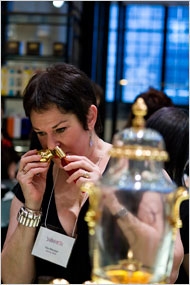
Ida Meister© 2012
“Smells, like music, hold memories. She breathed deep, and bottled it up for posterity.” ~ Arundhati Roy, The God of Small Things
Aroma and flavor are so intimately entwined that teasing apart one from the other can present a daunting challenge. Their marriage resembles Arachne’s web: exquisite, seamless, with no apparent inherent flaw – so unblemished as to anger the gods. Our sense of taste has long been lauded – whereas smell received short shrift early on, if one is to take Greek philosopher Aristotle at his word (in his magnum opus De Anima, On the Soul): “Our sense of smell is inferior to that of all other living creatures, and also inferior to all the other senses we possess.” Fortunately, numerous scholars and great intellects have disagreed with the ancient sage since this pronouncement was first voiced.
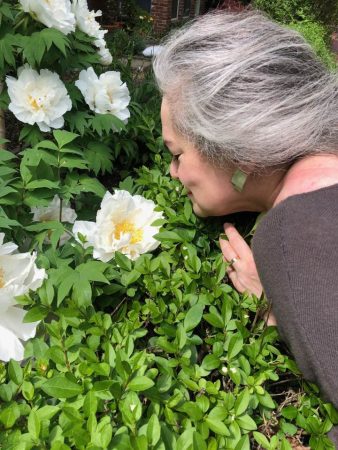
Ida Meister smelling roses©
Olfaction and gastronomy have been of a piece to me since earliest memory – a necessary means of defining my world. If I hadn’t already been obsessed with both (I was), I would have become so due to circumstance. Throughout my tenure on this mortal coil everything imaginable has found its way to my nose and into my mouth – much to the discomfiture of friends and family. Perhaps all young children are proponents of famous gastronome Jean Anthelme Brillat-Savarin, unbeknownst to themselves; certainly their behavior illustrates his maxim, “Smell and taste are in fact but a single composite sense, whose laboratory is the mouth and its chimney the nose.” Perfumers must have always suspected this, on some level – if the litanies of their fragrance notes, and our nostrils – are to be believed. Throughout this pandemic, one sees clearly the resurgence of gourmandise, a cornucopia of sweet and syrupy scents. This may represent a profound desire to immerse oneself in creature comfort and vestiges of less troubled, simpler times.
Pâtisserie aside – what about the more savory connection between our nose and mouth? The truly fragrance-obsessed will assure you that, while not advertised as widely as the fruity/flora/resinous amber and gourmand fragrances in mass media – the choices are legion for those among us who crave alternatives. Let’s explore these relationships (bearing in mind the sagesse of Brillat-Savarin): “Tell me what you eat, and I will tell you what you are; the discovery of a new dish does more for human happiness than the discovery of a new star.” Similarly, the wearing of a savory and singular aroma does a body and soul good – much as ingesting it might.
In perfumery there is a carryover and melding of elements and categories: the more innovative creatives employ what may appear to be a startling note (or more than one) which possesses a distinctly piquant, tangy or earthy quality. In lieu of tropical fruits (such as coconut, pineapple, mango, guava, melons), or berries, apples, pears and other fruit – dulcet beloved nutty tones like almond, hazelnut – or the overt foodiness of vanillic touches, cotton candy (maltol), chocolate, coffee or liqueurs/alcohol – I’d like to introduce divergent grouping. Let’s refer to them as Citrus/Herbal, Savory/Spice, Smoky/Meaty and Earthy/Vegetal.
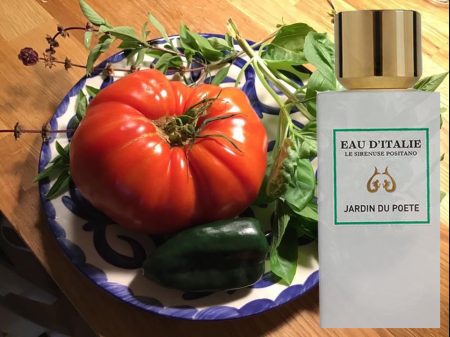
Eau d’Italie Jardin du Poete is citrus and herbal Heirloom tomato, Thai basil, basil and jalapeño pepper, photo by Ida Meister collage by Nicoleta Tomsa©
Citrus/Herbal fragrances just might be the largest classification when considering a non-cloying scent: they reinvigorate, delight and feel appropriate for every occasion. In years past, it was common to associate the lion’s share of them with a traditionally ‘masculine’ theme, but no longer: since when does crisp elegance reflect gender? Some fruits (besides lemon, lime, citron, grapefruit, tangerine, mandarin, yuzu) and flowers may wend their way into this category, but the overall impression remains mouthwatering. Those blossoms most likely to crop up will include jasmine, neroli, lavender, cassis and rose geranium (carnation, on occasion – as in Clarins’ Eau Dynamisante and the original Dior Eau Sauvage). You may note that I didn’t include tea alongside coffee earlier: although there are sweetly floral tea fragrances, tea is also treated in a savory manner, usually garlanded with citrus and/or herbs – as in Jean Laporte’s iconic L’Eau de L’Artisan for L’Artisan Parfumeur, where it is a marvel of refined lemon/verbena/tea garnished liberally with basil, mint and marjoram nestled into a subtly woody moss-infused base (Eau Dynamisante, Eau Sauvage and L’Eau de L’Artisan have been consumed bottle after bottle in our household consisting of three men and one woman.). Among the more unusual and perhaps controversial choices would be Pierre Guillaume Huitième Art Aube Pashmina, a dewy aubade bathed in tomato leaf, basil, rosemary and feisty cassis leaf (green, sappy, animalic, fruity). This scent is tangy and herbal; I feel it’s never received the acclaim it merits for all its sophistication. Similarly, Maître Parfumeur et Gantier’s Grain de Plaisir also polarizes: celery, myrrh, mint, Amalfi lemon and lavender create a unique palette. If you adore an herb garden by the sea, try Eau D’Italie Jardin du Poete; pure refreshment, Providence Perfume Co. Summer Yuzu; family-pleasing, Ô de Lancôme; and the chef’s beloved Le Galion Whip. On the very affordable side, irresistible LUSH Dirty fills the bill nicely with its amalgam of lavender and neroli woven into a web of mint, tarragon, thyme and oakmoss.
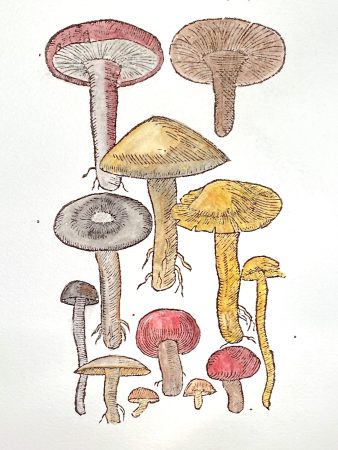
Photo courtesy of Mandy Aftel©
Savory/Spicy fragrances presents a challenge because many of the spicy fragrances one comes across often skew sweet. Here are a few which may at first appear odd and/or challenging, but are infinitely worth it. Do you want to smell like curry – truly? A big favorite in our home has been Diptyque L’Autre, aka Eau de Curry among my Indian cuisine-loving family. I bought a shower gel of it ages ago but when I went to use it, it had mysteriously disappeared; my eau de toilette diminished by the day. Smoky, spicy carnation buries itself beneath a cloak of caraway, cardamom, pepper, nutmeg and coriander; the base may include patchouli, but it smells nothing like Harvard or Washington Square in the 1970s. Contemplating the singular and utterly compelling brings us to DSH Perfumes (Dawn Spencer-Hurwitz) Wasabi Shiso: the list of aromatic components will either compel or confuse you, but one spritz and you’re smitten. How is it possible to combine a wasabi accord, shiso (a spicy Japanese mint), absinthe, basil, cucumber, vetiver, yuzu, bergamot, green tea and rose oil, kiss it with incense, vetiver and sandalwood and call it a day? Wasabi Shiso is a straddler – it could easily fit into the citrus/herbal and earthy/vegetal classifications. The darkest horse might be Pierre Guillaume Private Collection Querelle: the brief introduction of citruses yields way to a hot cinnamon and cool caraway, delving into a morass of incense, myrrh, vetiver, moss and driest amber. Querelle would probably glean a whole new generation of perfume lovers’ admiration currently; in 2006 when it was launched, it was an anomaly.
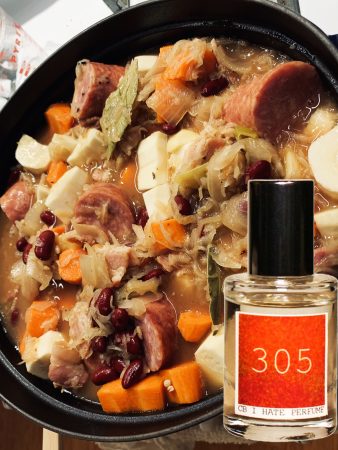
CB I Hate Perfume No. 305 Burning Leaves next to a pot of jota with kielbasa, by Ida Meister, collage by Nicoleta
Smoky/Meaty fragrances are an enigma to many – but omnivores (and carnivores in particular) may relish them. Be it gathering around a campfire or the aroma of charred meat, fragrances in this category can appear playful or earnest and/or be an acquired taste. One example of a playfully evocative scent is iconoclastic perfumer Christopher Brosius’s CB I Hate Perfume No. 305 Burning Leaves – which I purchased years ago and fondly refer to as “Eau de Kielbasa”. When I wore it to bed and my astute husband salivatingly inquired where the kielbasa was. Burning Leaves conjures an immense pile of smoldering maple leaves in autumn, pure and simple. We can gather around the campfire and go Old West with Tauer Perfumes Lonestar Memories – often referred to as a ‘woody chypre’, it smells more like an Old Testament burnt offering. Lonestar Memories charms with its clary sage and carrot seed (there’s a touch of geranium and jasmine in there to soften things a bit) before its leather and labdanum tones grab you by the throat; the heady base consisting of vetiver, myrrh, sandalwood contribute to its dusty aridity (tonka bean is also present, but don’t expect much modulating sweetness on its behalf). It’s fun to be a cowboy. If money is no object, the next stop might be Roja Parfums Great Britain – deeply, darkly meaty in its smoky wood raiment. Jasmine, rose de mai and violet may toy with you and saunter cavalierly to and fro; clary sage, carrot seed, and citrus notes flirt with you – but this base-heavy perfume is nothing short of spectacularly leathery, smoky meat, thanks to myriad varieties of wood, oakmoss, styrax, labdanum, juniper and patchouli.
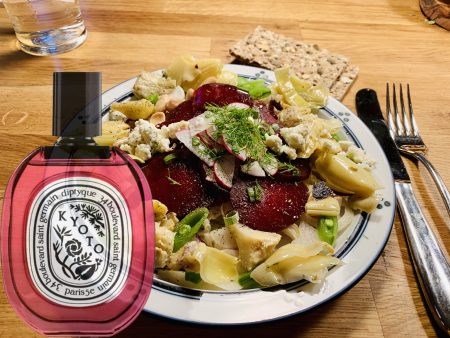
Diptyque Kyoto and fennel, grilled artichoke, bleu cheese and beet salad, by Ida Meister collage by Nicoleta©
Earthy/Vegetal fragrances are among the most fascinating due to their employment of novel, arresting tonalities; frequently flowers and exotic woods enmesh with vegetables, rhizomes, cheesy notes and mushroom. Some may find them to be alternately soothing, provocative – or repellent. A lovely example is Diptyque’s recent limited release (created to fête the house’s 60th anniversary): Kyoto, which sports a lusty beetroot note seamlessly complimented by luscious Turkish rose as vetiver and incense mirror a root vegetable earthiness. If the resonance of ripe black olives sprinkled with truffle and coal-roasted chestnuts appeals, there is a fragrance for that – Eau D’Italie Sienne l’Hiver, a portrait of the ancient Tuscan city in winter. A subtle violet caress, silken silvery iris and the coumarinic beauty of hay repose upon a sotto voce cushion provided by frankincense, dusky labdanum and guaiac wood; it’s mysteriously edible. Mushrooms, bleu cheese? Believe it or not, not all gardenias smell like a powder puff or floral candy: in its natural state, if you concentrate – you’ll pick up fresh greens, a very distinct ‘bleu cheese note’, and a loamy, mushroomy aspect. DSH Perfumes’ latest perfume in her Women Artist Series, Don’t Explain, is an umami floral (a term I coined when I first smelt it) which utilizes both this savory cheesiness and mushroom nuance; it was a few years in the making while striving to create a perfect, naturalistic gardenia perfume (one that Billie Holiday and I would adore). Would you like more mushroom? Natural perfumery icon Mandy Aftel of Aftelier composed Cepes and Tuberose years ago; she was ahead of her time – combining indolic tuberose with equally indolic, ribald mushroom. The effect is a chiaroscuro, lustrous floral carnality blended with the soil in all its earthly splendor. This fragrance is a pleasure to wear and dances joyfully on the flesh.
My intention was to whet your appetites for the possibilities which lie before you. Anyone who enjoys eating or cooking is certain to unearth a new delight amidst these fragrances which tempt the curious. Cuisine lovers will find that writer Thomas Mann knew whereof he spoke: ““If you are possessed by an idea, you find it expressed everywhere, you even smell it.”
~ Ida Meister, Deputy Editor and Natural Perfumery Editor
